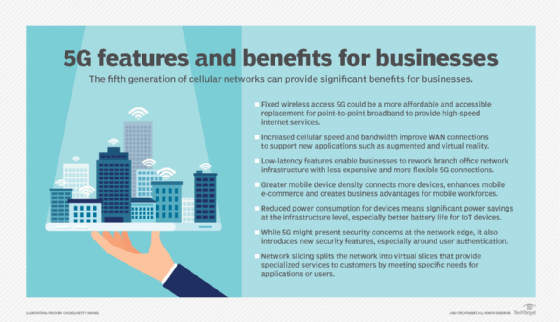What are the features and benefits of 5G technology?
Increased cellular speed, bandwidth and capacity at lower latencies have made wireless VR and AR practical for business use, enabling vertical industry apps and boosting IoT.
Telecom operators touted fifth-generation cellular technology, or 5G, as the wave of the future for both consumers and businesses. The hype about 5G's promise of high-speed, high-capacity wireless networks that enabled leading-edge, latency-sensitive applications made headlines. But stumbling blocks in the 5G rollout and performance issues left corporations and consumers alike less than impressed.
Over time, telecom providers worked out the kinks. Disruptions abated and performance revved up, laying the groundwork for 5G to provide the communication capabilities needed for advanced applications at the edge, including AI-driven ones.
Enterprise clients saw the light and have been replacing point-to-point broadband with the more cost-effective and accessible fixed wireless access 5G. Corporate network owners are also adding mobile 5G connections to tap into faster speeds and more bandwidth.
Their interest is understandable, given 5G's numerous features and benefits. Here are seven of the most important ones.
1. Speed and bandwidth
What first comes to mind when 5G is introduced into the technology conversation is lightning-fast transmission speeds and expansive bandwidth. With speeds as high as 20 Gbps, the cellular technology promises to be three to six times faster in production networks than its predecessor, 4G. 5G has made cellular a practical networking option for advanced applications, such as augmented reality (AR) and virtual reality (VR), ultra HD video streaming and telemedicine, because it gives WAN connections sufficient speed and bandwidth to support those applications.
2. Low latency
5G's low latency, which in production networks ranges between 1 and 10 milliseconds (ms), delivers numbers far superior to 4G's 50-100 ms. At that level, 5G can deliver the nearly instant transmission speeds required for applications like gaming and autonomous vehicles. 5G's low latency also brings flexibility that makes it possible for enterprises to jettison some of their branch-office infrastructure that is based on the WAN switching mechanism, MPLS, in favor of less expensive and more flexible 5G connections. This is especially true in retail, shared infrastructure and remote environments.
3. Capacity
5G has the capacity to support up to 100 times more connected devices in the same physical space than 4G LTE can. It can connect up to 1 million devices in a square kilometer while maintaining 99.999% availability. This density creates business advantages for mobile workforces and connected IoT devices in industries like manufacturing and healthcare, as well as in smart cities. For example, 5G's capacity for real-time transmissions from a massive number of devices supports healthcare applications like remote patient tracking through wearables and other devices.

4. Security
Security is a high priority in every aspect of the typical network, but particularly when mobile and IoT devices are involved. They make attractive targets because they are more vulnerable than systems that are locked down behind firewalls. While 5G security is constructed on the same principles as 4G, 5G has important security enhancements that deliver stronger encryption. 5G also provides a shield to guard user identities by obscuring subscriber IDs. It also delivers advanced authentication, including non-SIM-based authentication, which provides more options in IoT devices that are too small to fit a SIM card. 5G technology also provides more granular traffic isolation through network slicing.
However, the massive volume of traffic carried over 5G networks also introduces new security challenges. Tracking that much data can overwhelm network management systems and security, and end users must stay on top of security updates or risk exposing their devices to threats.
5. Coverage
5G improves coverage by using multiple frequency bands, employing intelligent beamforming to direct signals precisely, deploying smaller transmitters and cells and optimizing signal penetration with low-band frequencies. While high-band millimeter wave 5G offers higher speeds over shorter distances and doesn't penetrate obstacles well, low-band and midband 5G provide wider coverage and better building penetration to extend overall network reach.
Midband spectrum balances coverage and bandwidth, delivers improved services and offers a better cost model for higher data use. Network densification is driven by the lower propagation qualities of the high-frequency spectrum that 5G uses, which require more cells in a particular space. Making the network denser requires more base stations as well as small cell and macrocell base stations.
Massive multiple input, multiple output antenna technology extends coverage and network capacity in 5G networks. The technology facilitates the deployment of a large number of antennas at each base station to send and receive signals, improving both capacity and coverage.
6. Network slicing
Network slicing applies software-defined networking and virtualization to split the network into virtual slices. While network slicing is still not widely deployed, it is expected to become a popular way to monetize the technology and bring specialized services to customers.
Each network slice can adjust to meet the specific requirements of applications or user groups to best support their network, security and performance needs. Telecom operators can use network slicing to deploy services and new functions quickly to adapt to shifting market dynamics.
Network slicing introduces new revenue opportunities by delivering higher-value, customized services. These can include services for industries such as manufacturing, healthcare and finance. Network slicing can also be used for horizontal applications, including AR and VR.
7. Future technology adoption
To go back to the beginning, one of the most compelling promises of 5G is its potential to support innovative new technology and business uses. 5G is already providing high-speed internet services to businesses and consumers via fixed wireless access. Enterprises see it as a mechanism to support billions of connected devices as well as immersive entertainment applications and industrial automation.
In its 2025 "State of Enterprise Connectivity Report," the mobile networking vendor Ericsson found that 88% of those surveyed see 5G as critical to optimizing AI in the workplace. The study uncovered a symbiotic relationship between the two technologies, with 90% noting that AI elevates IT security by automating threat detection.
The healthcare industry is beginning to use 5G in conjunction with edge computing for a host of different applications, including remote patient monitoring, remote surgery, telemedicine and IoT medical devices.
Several industries, including oil and gas, manufacturing, utilities and construction, are using 5G for industrial automation applications. 5G-enabled edge computing can improve industrial automation by powering communications with robotics, drones and IoT sensors. Automotive and logistics companies are using the two technologies to build new autonomous vehicle applications.
While 5G is widely deployed in the U.S. today, applications are still being developed, including AI-powered software, to take full advantage of 5G's many attributes. 5G technology has become the network cornerstone that enterprises need to move forward from the bleeding edge to the future.
Amy Larsen DeCarlo has covered the IT industry for more than 30 years, as a journalist, editor and analyst. As principal analyst at GlobalData, she covers managed security and cloud services.







